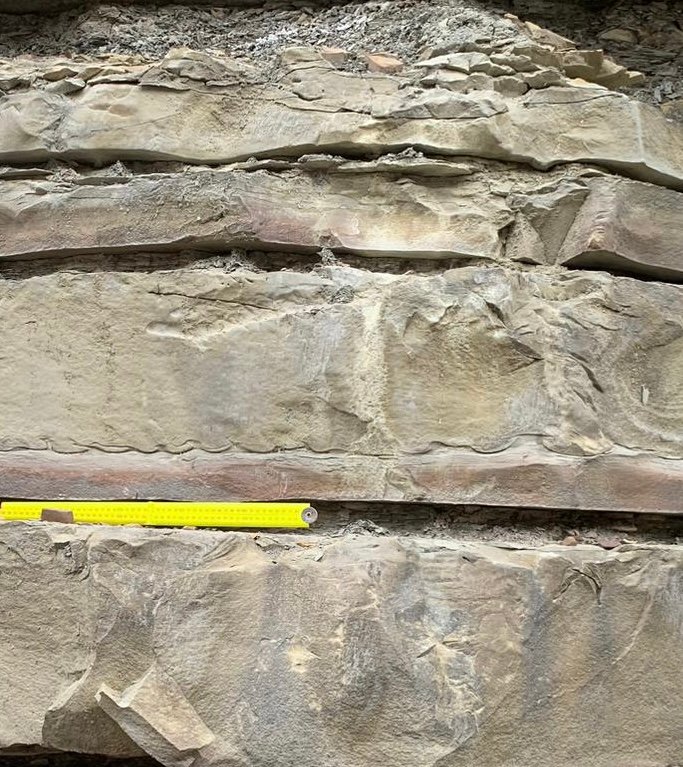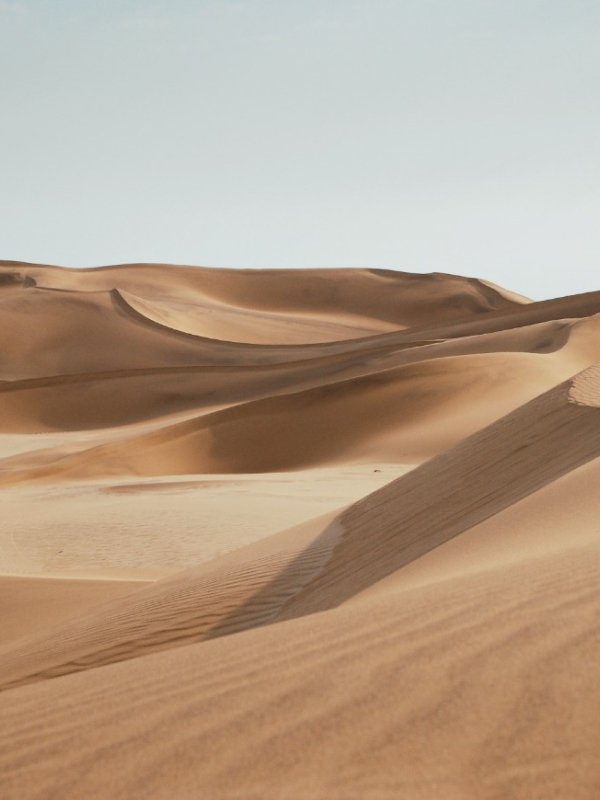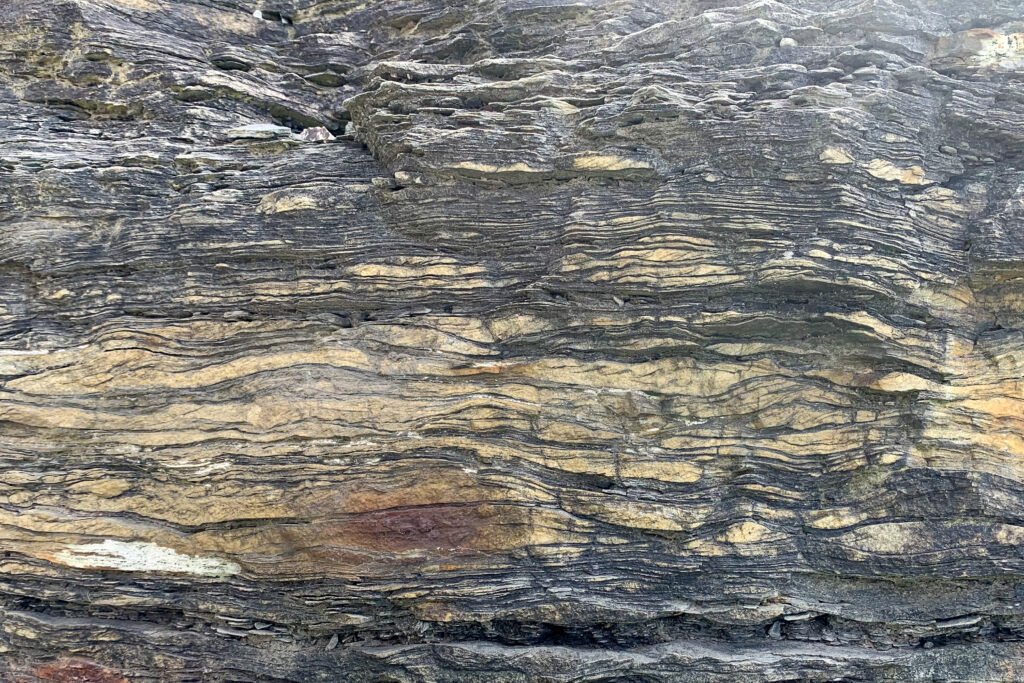Primary Structures
Formed during deposition; these are the building blocks of sedimentary structures.
Introduction to Primary Sedimentary Structures
Primary sedimentary structures form during or shortly after deposition, capturing the physical conditions of the environment in real time. These features are often the first clues used to interpret past processes such as current direction, flow strength, sediment load, and depositional setting.
In glacial and mass transport environments, primary structures can be influenced by meltwater streams, settling in proglacial lakes, or the waning energy of debris flows. Despite the sometimes chaotic nature of these systems, recognizable structures like lamination, cross-bedding, ripple marks, and graded bedding still emerge.
This section showcases examples of primary structures preserved in glacially influenced deposits; highlighting the textures and patterns that serve as a starting point for sedimentary interpretation.

Bedding and Laminations
Description:
Bedding and laminations are the most fundamental sedimentary structures, representing the visible layering of sediment as it accumulates over time. Bedding refers to larger, distinct layers typically greater than one centimeter thick, while laminations are finer-scale layers less than one centimeter in thickness. These structures often appear as horizontal or gently inclined bands of varying grain size, color, or composition.
Formation:
Bedding and laminations form through episodic or continuous sediment deposition, driven by changes in flow velocity, sediment supply, or depositional energy. In glacial and proglacial environments, they may result from fluctuating meltwater streams, lake settling processes, or sediment-laden underflows. Seasonal variations in sediment influx can produce rhythmic layering, as seen in varves.
Significance:
Bedding and laminations are key indicators of depositional processes and environmental stability. In glacial settings, they can record seasonal cycles, identify proglacial lake deposits, and distinguish between flow-dominated versus settling-dominated environments. Their presence helps establish stratigraphic context, identify primary depositional surfaces, and track temporal changes in energy or sediment input.

Planar and Trough Cross-Stratifications
Description:
Cross-stratification refers to inclined layers deposited by the migration of ripples or dunes. It is a common indicator of current flow. There are two primary types:
Planar cross-stratification is characterized by straight, parallel bounding surfaces with uniform foreset layers.
Trough cross-stratification exhibits curved or scoop-shaped sets, typically formed by migrating three-dimensional bedforms.
Formation:
Both types of cross-stratification form through sediment transport by unidirectional currents, such as those in rivers, subglacial meltwater channels, or deltaic environments. Planar sets typically result from two-dimensional dunes migrating in consistent flow, while trough sets form from three-dimensional dunes influenced by flow variability or channelized conditions.
Significance:
Cross-stratification is a key indicator of paleoflow direction and energy conditions. In glacial and proglacial environments, its presence often points to meltwater stream activity, outwash deposition, or deltaic foreset development. Planar sets suggest steady, laterally extensive flow, while trough sets indicate more complex flow regimes and localized turbulence.

Normal Grading and Reverse Grading
Description:
Grading refers to a vertical change in grain size within a single sedimentary layer.
Normal grading shows a decrease in grain size from bottom to top—coarse material settles first, followed by finer particles.
Reverse grading displays an upward increase in grain size, with finer particles at the base and coarser material near the top.
Formation:
Normal grading commonly forms during rapid sediment settling from suspension, such as in turbidity currents or meltwater plumes. It reflects waning flow energy, where heavier grains settle first.
Reverse grading typically develops in granular flows or debris flows, where kinetic sieving and dispersive pressure cause coarser grains to rise during transport.
Significance:
Graded bedding is an important indicator of depositional energy and transport mechanisms.
Normal grading is often associated with low-density turbidity currents, underflows in proglacial lakes, or meltwater sedimentation.
Reverse grading points to high-concentration flows like debris flows or rapid mass transport, common in proximal glacial and paraglacial settings.
Recognizing grading patterns can help distinguish between flow types, infer flow direction, and reconstruct sediment transport dynamics.

Fluctuating Flow Structures (Lenticular, Flaser, and Wavy Bedding)
Description:
These bedding types form under alternating current and low-energy conditions, where periods of traction transport are interrupted by settling from suspension.
Lenticular bedding consists of isolated sand lenses within a muddy matrix.
Flaser bedding contains thin streaks or lenses of mud interbedded with rippled sand.
Wavy bedding shows relatively equal amounts of sand and mud, forming undulating laminae.
Formation:
These structures develop in environments with fluctuating energy, such as tidal flats, ephemeral meltwater channels, or shifting lake margins. During high-energy phases, sand is deposited by ripples or small dunes. In low-energy intervals, fine mud settles from suspension and drapes the surface.
Significance:
Fluctuating flow structures are excellent indicators of periodically changing hydrodynamic conditions. In glacial and proglacial systems, they can signal tidal influence, meltwater pulse variability, or intermittent flooding in shallow basins. Their presence reflects depositional rhythms and helps identify transitions between traction and suspension-dominated processes.
